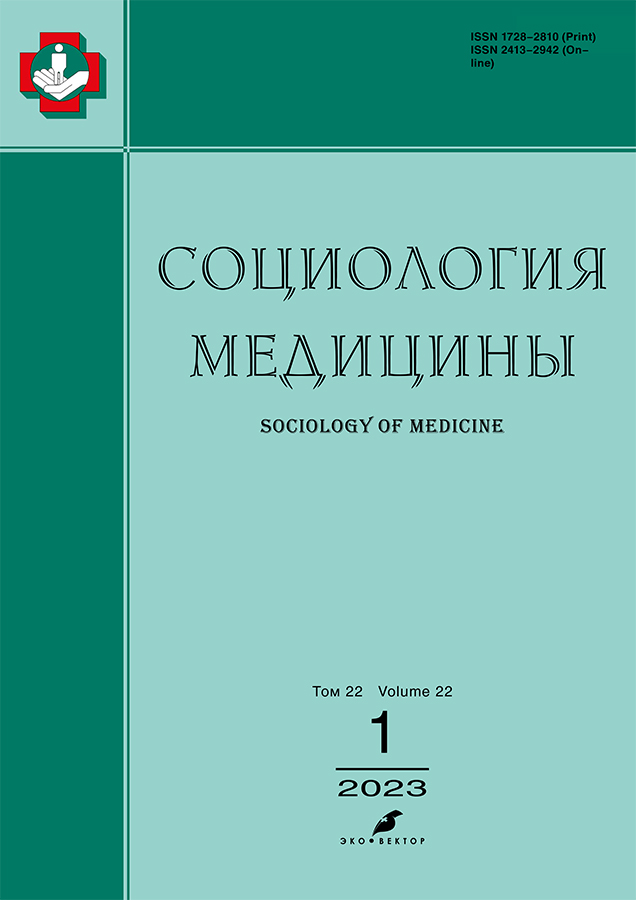Effect of financial deprivation on the quality of life of patients with traumatic brain injury
- Authors: Annikov Y.G.1, Krom I.L.1, Orlova M.M.2, Zotova Y.A.1, Subbotina V.G.1
-
Affiliations:
- Saratov State Medical University named after V.I. Razumovsky
- Saratov State University
- Issue: Vol 22, No 1 (2023)
- Pages: 71-77
- Section: QUALITY OF LIFE
- URL: https://rjsocmed.com/1728-2810/article/view/246030
- DOI: https://doi.org/10.17816/socm246030
- ID: 246030
Cite item
Abstract
BACKGROUND: Traumatic brain injury (TBI) is a global public health problem and one of the leading causes of mortality and disability. The prevalence and increase in the number of cases of TBI, high percentage of complications, disability, uncertain medical and social prognosis determine the relevance of studying this medical and social problem, the most significant in which are the consequences of craniocerebral trauma, often acquiring a chronic course, affecting the quality of life of the patient and his family.
AIM: To study the influence of financial deprivation on the quality of life of patients with post-TBI.
MATERIALS AND METHODS: The study of quality of life in patients with a post-TBI event was conducted using the WHOQOL-100 questionnaire. The study randomly sampled 414 respondents of working age (93.6% men). 54% of the respondents had suffered TBI within 1 to 5 years. The control group included clinically healthy subjects. The Dembo–Rubinstein test was used to diagnose the adequacy of respondents’ self-assessment with TBI. In the study of the impact of financial deprivation on the quality of life of the respondents, 4 degrees of deprivation correlated with the level of income per patient’s family member were considered.
RESULTS: The study of the impact of financial deprivation on the quality of life of patients with TBI identified 4 deprivation groups of respondents. The study obtained evidence of the effect of deprivation on the quality of life of respondents with TBI. The indicators of quality of life of patients included in the study significantly increase when moving from the group with degree 4 of deprivation to the group with degree 1 of deprivation. The greatest decrease in quality of life indicators was observed in respondents with degrees 2–4 of deprivation.
CONCLUSION: A multicomponent assessment of the results of TBI takes into account quality of life, a somatic and socially determined criterion of a patient’s social functioning that has prognostic value. The definition and typology of predictors of quality of life will allow the development of prognostic models of quality of life after TBI of different severity.
Full Text
About the authors
Yuri G. Annikov
Saratov State Medical University named after V.I. Razumovsky
Email: yuri-annikov@yandex.ru
ORCID iD: 0000-0002-7984-442X
SPIN-code: 2211-9629
Graduate student
Russian Federation, SaratovIrina L. Krom
Saratov State Medical University named after V.I. Razumovsky
Author for correspondence.
Email: irina.crom@yandex.ru
ORCID iD: 0000-0003-1355-5163
SPIN-code: 4854-1094
MD, Dr. Sci. (Med.), Professor
Russian Federation, SaratovMaria M. Orlova
Saratov State University
Email: orlova-maria2010@mail.ru
ORCID iD: 0000-0003-2340-8343
SPIN-code: 1399-9666
Cand. Sci. (Psy.), Assistant Professor
Russian Federation, SaratovYulia A. Zotova
Saratov State Medical University named after V.I. Razumovsky
Email: votoz73@mail.ru
ORCID iD: 0000-0002-6508-0502
SPIN-code: 1578-4636
MD, Cand. Sci. (Med.), Applicant
Russian Federation, SaratovVera G. Subbotina
Saratov State Medical University named after V.I. Razumovsky
Email: Sersubbotin@rambler.ru
ORCID iD: 0000-0002-6626-0791
SPIN-code: 3629-6100
MD, Cand. Sci. (Med.), Assistant Professor
Russian Federation, SaratovReferences
- Marklund N, Bellander BM, Godbolt AK, et al. Тreatments and rehabilitation in the acute and chronic state of traumatic brain injury. J Intern Med. 2019;285(6):608–623. doi: 10.1111/joim.12900
- Failla MD, Wagner AK. Models of posttraumatic brain injury neurorehabilitation. In: Kobeissy FH, editor. Brain neurotrauma: molecular, neuropsychological, and rehabilitation aspects. BocaRaton (FL): CRC Press/Taylor & Francis; 2015.
- Gerber LH, Deshpande R, Moosvi A, et al. Narrative review of clinical practice guidelines for treating people with moderate or severe traumatic brain injury. NeuroRehabilitation. 2021;48(4):451–467. doi: 10.3233/NRE-210024
- Maas AIR, Menon DK, Adelson PD, et al. Traumatic brain injury: integrated approaches to improve prevention, clinical care, and research. Lancet Neurol. 2017;16(12):987–1048. doi: 10.1016/S1474-4422(17)30371-X
- Chernenko II, Kufterina NS, Mishchenko VN, Voloshin-Gaponov IK. Comparative characteristics of the quality of life of persons who underwent battle traumatic brain injury. Georgian Med News. 2018;275(2):12–17.
- Haarbauer-Krupa J, Pugh MJ, Prager EM, et al. Epidemiology of chronic effects of traumatic brain injury. J Neurotrauma. 2021;38(23):3235–3247. doi: 10.1089/neu.2021.0062
- Reshetnikov AV. Activity of the Rostov oblast TFOMS aimed at improving the quality and availability of medical care as one of the aspects of improving the life of the population. Proceedings of the Scientific and practical conference with international participation «Sociological understanding of the integral concept of quality of life and methodology of its assessment»; 2019 Feb 5; Moscow. (In Russ).
- Harfmann EJ, deRoon-Cassini TA, McCrea MA, et al. Comparison of four quality of life inventories for patients with traumatic brain injuries and orthopedic injuries. J Neurotrauma. 2020;37(12):1408–1417. doi: 10.1089/neu.2019.6746
- Davydova NM. Deprivation approach to poverty assessment. Sotsiologicheskie issledovaniya. 2003;(6):88–96.
- Polinder S, Haagsma JA, van Klaveren D, et al. Health-related quality of life after TBI: a systematic review of study design, instruments, measurement properties, and outcome. Popul Health Metr. 2015;13:4. doi: 10.1186/s12963-015-0037-1
- Tunthanathip T, Oearsakul T, Tanvejsilp P, et al. Predicting the health-related quality of life in patients following traumatic brain injury. Surg J (N Y). 2021;7(2):e100–e110. doi: 10.1055/s-0041-1726426
- Hennessy M, Sullivan KA. Quality of life, community integration, service needs and clinical outcomes of people with traumatic brain injury in urban, regional and remote areas of Queensland, Australia. Aust J Rural Health. 2022;30(2):164–174. doi: 10.1111/ajr.12823
- Helmrich IRAR, van Klaveren D, Dijkland SA, et al. Development of prognostic models for Health-Related Quality of Life following traumatic brain injury. Qual Life Res. 2022;31(2):451–471. doi: 10.1007/s11136-021-02932-z
- Cohen ML, Lanzi AM, Boulton AJ. Clinical use of PROMIS, Neuro-QoL, TBI-QoL, and other patient-reported outcome measures for individual adult clients with cognitive and language disorders. Semin Speech Lang. 2021;42(3):192–210. doi: 10.1055/s-0041-1731365
Supplementary files







